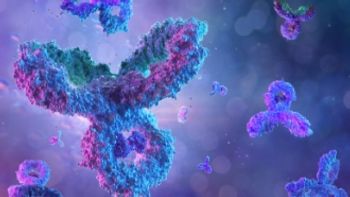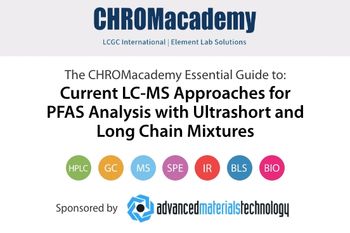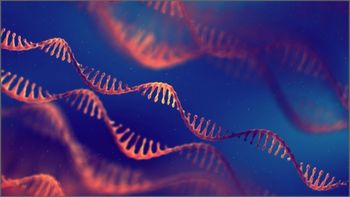
Mass Spectrometry Fundamentals and Applications
Monday and Tuesday, November 7th and 8th 2022 Morning sessions: 9:00 am – 12:15 pm EST Afternoon sessions: 2:00 – 4:00 pm EST Join us for two days of insightful talks on mass spectrometry (MS). Speakers will delve into theory and fundamentals of MS, elucidating common areas of confusion related to hardware, ionization options, data collection and processing, untargeted experiments, ion mobility, and imaging, as well as practical applications, in polymer and biopharmaceutical analysis as well as research fields like metabolomics and health and environmental studies. Speakers will address a range of MS types, such as triple-quadrupole MS (MS/MS), time-of-flight (TOF), and high-resolution MS (HRMS). We have a morning and afternoon session each day. There will be live Q&A for the morning sessions. Attendance is free.
Register Free:
Event Overview:
Mass spectrometry (MS) technologies are constantly advancing. New developments bring opportunity, but also sometimes lead to confusion about how to best harness the techniques and get the optimal results. In this exciting virtual symposium, we bring together leading scientists for two days of insightful talks. Each day will start with two talks on fundamentals of MS, elucidating common areas of confusion related to mass analyzer types, ionization options, untargeted analysis experiments, and ion mobility. In the subsequent three talks each morning, speakers will delve into practical applications, in industrial use (polymer analysis and biopharmaceutical applications) and research (metabolomics, proteomics, cell biology, and health and environmental research). Speakers will address a range of MS types, such as quadrupole, triple-quadrupole MS (MS/MS), time-of-flight (TOF), and high-resolution MS (HRMS), and techniques, including ion mobility and imaging MS. In the afternoon, event sponsors will share useful information about best practices, troubleshooting, and applications. There will be live Q&A for the morning sessions. Attendance is free.
Key Learning Objectives:
- Gain a better understanding of mass spectrometry fundamentals, including how different types of mass spectrometers work, ionization choices for LC–MS and GC–MS, data analysis, ion-mobility MS, and MS imaging
- Learn how to set up your analytical process for untargeted LC–MS analysis
- Hear how MS is being used in practical applications in polymer analysis, biopharmaceutical analysis, metabolomics, environmental and health research, and MS imaging
Who Should Attend:
- Analytical chemists and technicians wishing to learn more about the fundamentals of mass spectrometry, from hardware types to ionization to data collection, as well as untargeted analysis
- Mass spectrometry users seeking to advance their understanding of MS technologies, such as MS imaging, ion-mobility MS
- Analytical chemists and technicians in industrial settings who wish to learn from examples of practical use – in areas such as biopharmaceutical analysis, polymers, metabolomics, and more
- Researchers, academics, and students who wish to fill in gaps in MS knowledge or learn about recent applications of MS
Monday, November 7, 2022
Morning session: 9:00 am – 12:15 pm EST
Mass Spectrometry Theory and Applications I
9:00 am Mass Analyzers: An Overview of Common Mass Spectrometers and How They Work
Richard W. Vachet, Professor of Chemistry, University of Massachusetts Amherst
The objective of this presentation is to provide an overview of the principles and operation of common mass analyzers used in mass spectrometry. The presentation will provide an introduction to the fundamentals of the mass spectrometers that are commonly used and should provide listeners with enough insight to be able to make an informed choice about which mass spectrometer to utilize based on their experimental needs. Mass analyzers to be covered include quadrupole, triple quadrupole (tandem MS), quadrupole ion trap, orbital trap, time-of-flight (TOF), and Fourier transform ion cyclotron resonance (FT-ICR) systems, as well as hybrid instruments involving these mass analyzers. Basic terminology, principles of operation, and analytical figures of merit, such as resolving power and mass accuracy, for the different analyzers will be covered.
9:30 am Ion Source Fundamentals for Liquid Chromatography–Mass Spectrometry and Gas Chromatography–Mass Spectrometry
Kevin A. Schug, The University of Texas Arlington
Mass spectrometry detectors for chromatography provide exceptional quantitative and qualitative capabilities. To perform mass spectrometry, molecules separated in the gas or liquid phase must be converted into gas-phase ions. These ions can then be manipulated and sorted under high vacuum using electric and magnetic fields. Fundamental aspects of common ionization sources will be covered in this presentation. Electron ionization and chemical ionization are the prominent means to couple gas chromatography with mass spectrometry. Atmospheric pressure ionization sources, such as electrospray ionization and atmospheric pressure chemical ionization, are primarily used to couple liquid chromatography with mass spectrometry. Each source has different advantages and disadvantages, and these will be discussed along with how each source is operated and optimized.
10:00 am LC–MS Based Discovery Metabolomics in the Search for Biomarkers for Ascaris Lumbricoides Infection
Ruben t’Kindt, Head of LC-MS, RIC Group, Kortrijk, Belgium (speaker); Ole Lagatie, Janssen Global Public Health, Janssen R&D, Beerse, Belgium; Lieven J. Stuyver, Janssen Global Public Health, Janssen R&D, Beerse, Belgium; Koen Sandra, President, RIC Group
Infections with intestinal worms, such as Ascaris lumbricoides, affect hundreds of millions of people in all tropical and subtropical regions of the world. This talk covers the quest for a small-molecule biomarker for A. lumbricoides infection in plasma and urine. A discovery metabolomics analysis, based on untargeted liquid chromatography–mass spectrometry (LC–MS), enabled the selection and identification of a specific urine biomarker 2-methyl pentanoyl carnitine (2-MPC). After its discovery, 2-MPC has been evaluated in different sample sets from different endemic regions. The correlation of this marker with infection intensity and the fact that treatment with an anthelminthic results in greatly reduced concentrations of this molecule suggest an intimate relationship between this novel biomarker and the infection with adult A. lumbricoides.
10:30 am Mass Spectrometry in Polymer Analysis
Chrys Wesdemiotis
Department of Chemistry and School of Polymer Science & Polymer Engineering, The University of Akron
The dispersive power of mass spectrometry (MS) and its high sensitivity, specificity, and dynamic range have resulted in continuously increasing applications in polymer and materials science. Single-stage MS converts the sample to gas-phase molecular ions that reveal the masses of the individual oligomers present, from which fundamental information about the polymer can be deduced, such as repeat units, total end group mass, and functionality, as well as molecular weight distributions. Impurities and byproducts with unique masses are easily identified in the raw product without the need of fractionation or purification. MS is readily interfaceable, inline, with additional separation and characterization techniques for more detailed structural information. Thus, adding the tandem mass spectrometry (MS/MS) dimension allows for determination of individual end group substituents, chain sequence (of copolymers), and architecture based on fragmentation chemistry. Similarly, adding the ion mobility (IM) dimension enables the separation and differentiation of oligomers, including isomers and isobars, based on 3D shape and size variations. For more complex mixtures and blends, these techniques can be combined with online or offline liquid chromatography (LC) to separate the sample based on polarity or hydrodynamic volume differences before MS, MS/MS, or IM-MS characterization. Conversely, large, crosslinked, and/or insoluble materials can be made analyzable by coupling MS, MS/MS, or IM-MS with mild thermal degradation that preserves connectivity detail. These techniques are also suited for the characterization and imaging of polymer surfaces if a surface-specific ionization technique is employed. The described multidimensional characterization approaches permit the confident microstructure elucidation of a broad range of polymeric materials, as will be demonstrated for variously shaped (co)polymers, complex conjugate blends, crosslinked materials, and solid surfaces.
11:00 am Use of UVPD-MS to Characterize Protein–Ligand Complexes Governed by Different Binding Affinities
Ines Santos, Bristol Myers Squibb
The talk will focus on the use of native ultraviolet photodissociation (UVPD)-MS to evaluate conformational re-organization of carbonic anhydrase, a well-studied protein, upon binding of sulfonamide ligands with different affinities. UVPD is a versatile tool for the characterization of protein-ligand interactions as it promotes fragmentation while maintaining non-covalent interactions. In this study, variations in UVPD fragmentation of protein versus protein complexes were evaluated and showed some structural changes of the protein after ligand binding. No significant changes in fragmentation were observed for the three arylsulfonamides examined despite their differences in binding affinities.
11:30 am Live question-and-answer period with all the speakers in the session
12:15 pm Session close
Afternoon session, 2:00–4:00 pm EST
Mass Spectrometry Best Practices, Tips, Tricks, and Applications from Our Sponsors
2:00 pm EST Rapid, Simplified VOC Analysis using SIFT-MS
Leslie Silva- Application Scientist- Syft Technologies
SIFT-MS is a direct-injection mass spectrometry technique that provides real-time, selective, and economic analysis of volatile compounds in the gas phase. In addition to routine VOCs, chromatographically challenging volatiles, such as formaldehyde, nitrosodimethylamine (NDMA), and ethylene oxide are analyzed in real time without requiring derivatization or other special handling. This webinar will cover SIFT-MS applications in various industries, including real-time analysis of benzene in commercial products, mobile monitoring of BTEX, it’s use as an alternative method to USP <467> for residual solvent analysis, high-throughput nitrosamine screening and rapid, high sensitivity measurement of ethylene oxide from Polysorbate 80. SIFT-MS is able to not only allow for real time measurement of VOCs and contaminants in ambient air, but to increase sample throughput in the pharmaceutical and manufacturing industries by 10- to 25-fold.
2:20 pm EST Creating Controlled Relative Humidity for Calibrating Gas Monitors, Sensors, and Detectors
Danet M. Vrazel- Vice President and General Manager, Kin-Tek Analytical, Inc.
Many industries monitor atmospheric conditions to measure gas pollutants in humid environments. Varying levels of ambient humidity can interfere with gas monitors and sensors and diminish response factors. Calibration of gas monitoring and detection devices should relate to ambient conditions and include the percent relative humidity (%RH) consistent with surrounding areas. Creating various %RH levels in a zero-gas stream or a calibration gas stream can be challenging and ineffective if done improperly. A permeation system that supplies accurate calibration gas with controlled %RH at varying levels is an effective solution for calibrating or exposing monitors, detectors, and sensors at ambient conditions.
2:40 pm EST Title of talk TBA
Fadi Abou-shakra- Director of ICP-MS Portfolio, Advion Interchim Scientific
Details to come.
Tuesday, November 8, 2022
Morning session: 9:00 am – 12:15 pm EST
Mass Spectrometry Theory and Applications II
9:00 am The Analytical Process for Untargeted Analysis with LC–MS
Tiffany Liden, University of Texas Arlington
Chemical profiling with liquid chromatography–tandem mass spectrometry (LC–MS/MS) in a targeted analysis process has become a valuable tool that can offer relative ease of sample preparation and rapid sample runs. Often, though, insight into the variations in a sample set can be better discovered in untargeted analysis using high-resolution mass spectrometry, such as a QTOF instrument (LC–QTOF-MS). However, the large data sets often generated in untargeted analysis, which frequently yield upward of 20,000 features or more, can be overwhelming. Join us for an overview of the process of untargeted analysis with LC–QTOF-MS. Discover the difference between targeted and untargeted analysis. Learn the key elements in creating an experimental design for untargeted analysis, which is one of the most pivotal aspects to verifying statistical variance in a sample set. Additionally, discover tools and the process to help facilitate data reduction and cleanup.
9:30 am Ion Mobility-Mass Spectrometry: Fundamentals and Instrumentation for Structural Separations
John A. McLean, Vanderbilt University
The integration of ion mobility with mass spectrometry provides rapid (µs-ms) two-dimensional post-ionization separations of biomolecules on the basis of analyte structure (apparent ion surface area) by ion mobility and subsequently by mass-to-charge (m/z) using mass spectrometry. Over the past two decades, IM-MS strategies have found widespead applications in the analysis of complex samples, where high throughput and broad molecular characterization are necessary. Analogous to mass spectrometry instrumentation, many different commercial arrangments exist for performing IM-MS, each with particular strengths in complex sample analysis. The theory and fundamentals of 2D IM-MS separations and instrumental arrangements are described. Applications requiring rapid and deeply comprehensive molecular characterization are discussed to illustrate the unique information afforded by IM-MS with a particular emphasis in biomedicine and biotechnology.
10:00 am Ion Mobility Spectrometry: From Instrumental Advances to Understanding the Intersection between Human Health and the Environment
James N. Dodds, Kaylie I. Kirkwood, Rebecca Beres, Jack Ryan, Anna Boatman, Jessie Chappel, Melanie T. Odenkirk, Karen Butler, and Erin S. Baker (speaker), University of North Carolina at Chapel Hill
To date, the use of mass spectrometry (MS)–based analyses has provided extensive knowledge for many different ‘omics studies, especially as a result of recent advancements in complex sample extractions, front-end chromatography separation, fragmentations strategies, database construction, and bioinformatics tools. However, numerous analytical challenges still remain in MS studies including the analysis of isomeric molecules, suppression of low-abundance species in complex samples, disparities in ionization efficiency, and difficulties in data analysis and molecular annotation. Because of these obstacles, both experimental and computational advances are still greatly needed to enable better ‘omics measurements. In this presentation, I will showcase how ion mobility spectrometry (IMS) has advanced throughout the last 30 years, resulting in IMS separations with higher sensitivity, throughput, and resolving power. These improvements have enhanced the coupling of IMS with various chromatography and MS platforms and provided 3- and 4-dimensional analyses in measurements, using liquid chromatography (LC) combined with IMS and MS (LC–IMS-MS) or also combined with collision-induced dissociation (LC–IMS-CID-MS). Currently, these multidimensional analyses are facilitating the separation of highly similar molecules, increasing the number of observed features, and providing improved identification confidence. Furthermore, applications ranging from clinical analyses to environmental assessments are incorporating these simultaneous separations to enable the in-depth ‘omics evaluations necessary for the complex sample types.
10:30 am Bringing Molecular Analysis into Focus: Technologies for Advanced Multimodal Imaging Mass Spectrometry
Jeff Spraggins, Vanderbilt University
Imaging mass spectrometry (MS) is a powerful technology that enables untargeted, highly multiplexed in situ molecular imaging for a wide range of biomolecular classes. However, without improved specificity, interpretability and biological insight can be limited for imaging MS experiments. Molecularly, the ability to exhaustively identify the ions observed in imaging MS experiments is critical for determining the exact molecular and mechanistic changes associated with biological processes. It is also necessary to be able to link observed molecular distributions directly to specific cell types and anatomical features unambiguously to provide proper biological context. Here I will describe our recent advancements in MALDI imaging MS instrumentation and multimodal data integration for addressing these key challenges.
11:00 am Native Mass Spectrometry–Based Strategies for Profiling Complex Biotherapeutics
Wendy Sandoval (speaker) (1), Romain Huguet (2), Luis Schachner (1), Christopher Mullen2, Josh Hinkle (2), Wilson Phung (1), Roberto Gamez (2), John Syka (2), Vlad Zabrouskov (2), Rosa Viner (2), Weijing Lui (2), Jared Otto Kafeder (3), Neil Kelleher (3), Kristina Szrentic (2), and Mike Senko (2); Affiliations: (1) Genentech, Inc.; (2) Thermo Fisher Scientific; (3) Northwestern University
Characterization of biotherapeutic moieties typically involve the application of multiple orthogonal analytical methods to evaluate product quality and purity. Investigations into molecular traits include the evaluation of aggregates, variants, degradation products, and post-translational modifications such as glycosylation. As modalities evolve beyond monoclonal antibodies and increase in their complexity, strategies to resolve proteoforms within a single molecule have become increasingly critical. Here we showcase hyphenated native mass spectrometry approaches to profile heavily glycosylated Fc fusion proteins, other engineered biotherapeutics, and biologically relevant proteins. We present results on “undeconvolvable” mass spectra in which charge-state resolution cannot be determined. We utilize charge detection mass spectrometry (CD-MS) and introduce a segmented acquisition strategy for proton transfer charge reduction (PTCR). This methodology has universal applicability for the profiling of spatially unresolved proteoforms from a single moiety.
11:30 am Live question-and-answer period with all the speakers in the session
12:15 pm Session close
Afternoon session, 2:00–4:00 pm EST
Mass Spectrometry Best Practices, Tips, Tricks, and Applications from Our Sponsors
Speakers:
Richard W. Vachet
Professor of Chemistry, University of Massachusetts Amherst
Kevin A. Schug
The Shimadzu Distinguished Professor of Analytical Chemistry, The University of Texas Arlington
Ruben t’Kindt, Head of LC-MS, RIC Group, Kortrijk, Belgium
Chrys Wesdemiotis
Department of Chemistry and School of Polymer Science & Polymer Engineering, The University of Akron
Ines Santos
Research Scientist, Nonclinical Research and Development group, Bristol-Myers Squibb
Tiffany Liden, PhD
Research Scientist at the University of Texas Arlington (UTA)
John A. McLean
Stevenson Professor of Chemistry and Chair, Associate Provost for Doctoral Programs, Director of the Center for Innovative Technology, Vanderbilt University
Erin S. Baker
Associate Professor at the University of North Carolina at Chapel Hill
Jeff Spraggins, PhD
Assistant Professor, Department of Cell & Developmental Biology, and Director, VU Biomolecular Multimodal Imaging Center, Mass Spectrometry Research Center, Vanderbilt University
Wendy Sandoval
Director, Translational Mass Spectrometry and Senior Principal Scientist, Department of Microchemistry, Proteomics and Lipidomics, Genentech, Inc.
Register Free:
Newsletter
Join the global community of analytical scientists who trust LCGC for insights on the latest techniques, trends, and expert solutions in chromatography.





